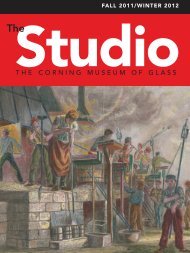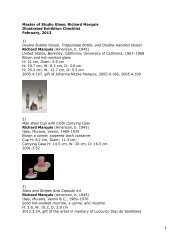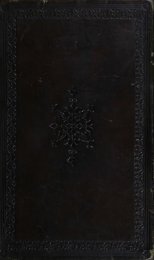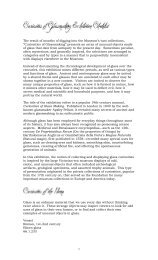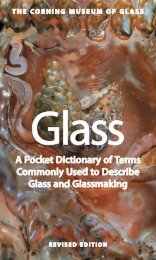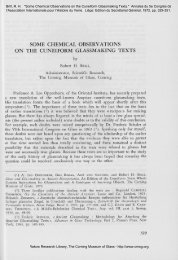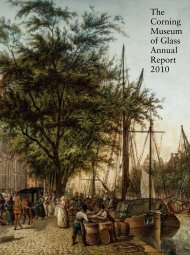english cameo glass in the corning museum of glass
english cameo glass in the corning museum of glass
english cameo glass in the corning museum of glass
Create successful ePaper yourself
Turn your PDF publications into a flip-book with our unique Google optimized e-Paper software.
esist for acidiz<strong>in</strong>g this out which was a fairly<br />
long job as it was fairly thick <strong>in</strong> outer coat<strong>in</strong>g to<br />
get <strong>the</strong> necessary relief. Mr. John Northwood<br />
than [sic] took it <strong>in</strong> hand for carv<strong>in</strong>g with Steel<br />
po<strong>in</strong>ts and <strong>the</strong> engravers la<strong>the</strong> he used a little." 7<br />
The draw<strong>in</strong>g reproduced <strong>in</strong> Fig. 13 was formerly<br />
<strong>in</strong> <strong>the</strong> possession <strong>of</strong> <strong>the</strong> Northwood family, and<br />
it is firmly attributed to John Northwood. Presumably,<br />
Woodall was responsible for copy<strong>in</strong>g<br />
Northwood's design on <strong>the</strong> blank.<br />
Ano<strong>the</strong>r <strong>of</strong> Northwood's assistants was<br />
Edw<strong>in</strong> Grice. He worked on <strong>the</strong> handles <strong>of</strong> <strong>the</strong><br />
Portland Vase, and <strong>in</strong> 1913 he recorded how <strong>the</strong><br />
object was cracked:<br />
We had got <strong>the</strong> vase <strong>in</strong>to a very forward condition,<br />
hav<strong>in</strong>g worked upon it for two years,<br />
and we contemplated ano<strong>the</strong>r journey to<br />
compare it with <strong>the</strong> orig<strong>in</strong>al. Before we<br />
started early for London we had a terrible<br />
mishap. The night had been very frosty, and<br />
when <strong>the</strong> vase was be<strong>in</strong>g lifted carefully <strong>in</strong>to<br />
<strong>the</strong> box someth<strong>in</strong>g went crack. We afterwards<br />
found that <strong>the</strong> hold<strong>in</strong>g <strong>of</strong> <strong>the</strong> vase <strong>in</strong><br />
warm hands had caused uneven expansion,<br />
produc<strong>in</strong>g a fracture. It put a damper on our<br />
spirits, as you may guess. 8<br />
Northwood's Portland Vase was not his first<br />
<strong>cameo</strong> <strong>glass</strong> vessel. About 1856, he produced a<br />
white-over-blue vase depict<strong>in</strong>g Perseus and Andromeda.<br />
Unfortunately, <strong>the</strong> vase was broken<br />
and no longer exists, but <strong>the</strong> Rakow Library has<br />
a pencil sketch <strong>of</strong> <strong>the</strong> design, which was once <strong>in</strong><br />
<strong>the</strong> collection <strong>of</strong> Kenneth Northwood, <strong>the</strong> artist's<br />
grandson. John Northwood also made an acidetched,<br />
colorless version <strong>of</strong> <strong>the</strong> Portland Vase,<br />
perhaps <strong>in</strong> preparation for his attempt to produce<br />
a colored replica.<br />
Northwood was <strong>in</strong>strumental <strong>in</strong> <strong>the</strong> completion<br />
<strong>of</strong> about 15 o<strong>the</strong>r replicas <strong>of</strong> <strong>the</strong> Portland<br />
Vase. This came about because he was <strong>the</strong> first<br />
person to apply to ceramics <strong>the</strong> techniques <strong>of</strong><br />
engrav<strong>in</strong>g and polish<strong>in</strong>g <strong>glass</strong>, and his etchers<br />
and engravers decorated large quantities <strong>of</strong><br />
Wedgwood's popular Rock<strong>in</strong>gham Ware. They<br />
also f<strong>in</strong>ished some <strong>of</strong> Wedgwood's copies <strong>of</strong> <strong>the</strong><br />
Portland Vase made between 1877 and 1880.<br />
Northwood's role was to gr<strong>in</strong>d and polish<br />
Wedgwood's jasperware vases, and sometimes to<br />
improve <strong>the</strong> decoration by cutt<strong>in</strong>g. The relationship<br />
between Northwood and <strong>the</strong> Wedgwood<br />
company was difficult, as some <strong>of</strong> <strong>the</strong>ir correspondence<br />
(preserved <strong>in</strong> <strong>the</strong> Rakow Library)<br />
reveals. On occasion, Wedgwood sent defective<br />
vases <strong>in</strong> <strong>the</strong> expectation that Northwood could<br />
elim<strong>in</strong>ate or conceal <strong>the</strong> defects, which sometimes<br />
proved to be impossible. Thus, on<br />
September 24, 1879, Wedgwood asked Northwood<br />
to "cut up <strong>the</strong> feet <strong>of</strong> cupid <strong>in</strong> <strong>the</strong> best way<br />
you can," and two days later, Northwood reported:<br />
"In cutt<strong>in</strong>g <strong>the</strong> Cupids {sic] foot, it was so<br />
hollow that <strong>the</strong> piece came <strong>of</strong>f." If <strong>the</strong> correspondence<br />
at Corn<strong>in</strong>g is typical, <strong>the</strong> Wedgwood<br />
company was a demand<strong>in</strong>g customer, and Northwood<br />
treated it with considerable patience.<br />
To <strong>the</strong> best <strong>of</strong> our knowledge, John Northwood<br />
personally completed only n<strong>in</strong>e pieces <strong>of</strong><br />
<strong>cameo</strong> <strong>glass</strong>: <strong>the</strong> vase with Perseus and Andromeda<br />
(about 1856); <strong>the</strong> Portland Vase (1876);<br />
The Milton Vase (1878); three tazzas, with portraits<br />
<strong>of</strong> Sir Isaac Newton (1878), William<br />
Shakespeare (1880), and John Flaxman (1880);<br />
ano<strong>the</strong>r tazza with a portrait <strong>of</strong> Shakespeare (see<br />
page 22); a pendant with a portrait <strong>of</strong> Shakespeare<br />
(after 1880); and <strong>the</strong> Dennis or Pegasus<br />
Vase (1882).<br />
The Milton Vase, commissioned by Philip<br />
Pargeter <strong>in</strong> 1878, was <strong>in</strong>spired by John Milton's<br />
Paradise Lost. The vase depicts Adam and Eve<br />
<strong>in</strong> <strong>the</strong> Garden <strong>of</strong> Eden. Adam raises his arm and<br />
po<strong>in</strong>ts to <strong>the</strong> figure on <strong>the</strong> o<strong>the</strong>r side <strong>of</strong> <strong>the</strong> vase,<br />
<strong>the</strong> archangel Michael.<br />
FIG. 15. The Milton Vase, by John Northwood



